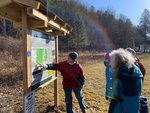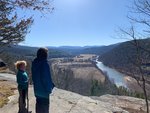

Growing up in the suburbs, we played in the streets, at school playgrounds, parks, and the undeveloped, leftover spaces. When we were little, our parents drove us to a tiny park about a mile away. We called it the Running Park. Besides a couple of benches, there was a paved loop path, about a tenth of mile per circuit. This was the perfect antidote to hyper kids. Round and round we’d go, until we had enough. As a parent, I’ve since employed like tactics with great success, and I thank my parents in a retrospective way for getting us out there. A key underlying point here is that these places exist. When there is foresight and persistence to integrate parks within our communities, the dividends are enjoyed by succeeding generations.
In the Catskill Region, we have an inverse relationship in comparison to the city. This region is largely defined by its expansive and preserved lands, while concentrated settlements occupy only a small percentage of the land mass. In a way, there is no shortage of parkland. Often overlooked, however, is how these lands can be better connected to hamlets and villages and offer benefits to residents and visitors. The ability to facilitate these connections is largely dependent on landowners. In cases where New York City owns the land, many successful connections have been made, complementing the amenities in our communities. Prattsville is a walkable hamlet in that sidewalks connect shops, the diner, the town hall, the village green and playground, the post office, the supermarket, and the Pratt Museum. Pedestrian crossings of Main Street (state Route 23) are also marked and signed. The origins of the street network are attributed to Zadock Pratt. Although he is known for his tannery enterprises, and hence the widespread assault on hemlock trees, his biography reveals that he was said to have planted more than 1000 trees in the hamlet. It’s interesting to point out that Pratt possessed a special combination of leadership and inspiration that built not just streets and buildings, but a shared work ethic to achieve success.
Besides the town’s name, Pratt is most well known for Pratt Rock, the series of cliff carvings he commissioned during his lifetime. Located at the eastern end of the hamlet, Pratt Rock Park cannot be reached by the sidewalk, which ends, unfortunately, about a quarter mile short of the park. However, and fortunately, the sidewalk’s terminus also coincides with a spur of the 422-acre Huntersfield Creek Unit, owned by NYCDEP. The parcel extends upward and behind the hamlet. Over the years, efforts to develop a hiking trail involved the New York–New Jersey Trail Conference, the Huntersfield Christian Training Center, the Catskill Center, the Catskill Mountain Club, the town of Prattsville, NYCDEP, the Greene County Soil & Water Conservation District, and many volunteers. With the .9-mile Huntersfield Creek Falls Trail loop now complete, a group of hikers recently gathered to enjoy a sunny morning.
Quite frigid at the start, my two sons took off, putting today’s Running Park plan into action. There’s a solid bridge to get you over the wetland and to provide access for mowing machinery. For such a short trail, so much is offered. Walking up through the old farm field, you immediately enjoy the views emerging with the gain in elevation. At the top of the field a snow-dusted Bearpen Mountain (3619’) punctuates the skyline to the south. Entering the hemlocks the rushing water pulls you toward the ravine, which has several little waterfalls. We paused at the largest drop and discussed the remnants of an old dam, which may have been the hamlet’s water supply at one time.
We then explored field and forest with the intention of connecting to Pratt Rock, which is on adjacent town land. Making this connection with a marked trail is a longstanding objective of the town, as is the restoration of Pratt Rock Park - both sculpture and landscape. (Some 14 years ago, I walked from the sidewalk to the top of Pratt Rock with DEP staff. Their primary concern with a proposed trail was ensuring protection of the wetland, which is now handily accomplished by the bridge.) Moving across and up through white pines and hemlocks, the hiking group soon hit the unmarked trail that connects the park and its stone carvings with the ledges above. I’m guessing that many visitors to the park are not aware of these scenic ledges. If there’s a ratio of shortest distance hiked and quality of viewpoint, these ledges rank extremely high.
Revitalization activities have been pretty much ongoing in Prattsville since the devastating floods of Hurricane Irene in 2011. In 2019, the Pratt Museum and the town hosted an energized reception and a packed meeting at which renowned landscape architect Michael Van Valkenburgh (and team) presented revitalization concepts for Pratt Rock Park. For Van Valkenburgh, who grew up on a dairy farm in neighboring Lexington, this was a return to a landscape that inspired him as a youth and influenced his choice of career. Meanwhile, the partnerships that brought the Huntersfield Trail into being embody a collective spirit that seems to carry out the same motivational principles embraced and realized by town founder Zadock Pratt.
I know everyone enjoyed the hike. And two of the hikers reported that they returned to the trail the next day with friends and family. The juxtaposition of town and country is especially appreciated when you can move easily between them on foot. The simple pleasure of ducking off the end of downtown sidewalk to explore the local hinterlands stirs an excitement for adventure. Through fields, into woods and alongside waterfalls, one’s motion is paused by peaceful vistas of mountains and valleys, only to return to what becomes the beginning of the sidewalk.
Peter Manning is the executive director of the Catskill Mountain Club. To learn about CMC events, membership, and projects visit catskillmountainclub.org.